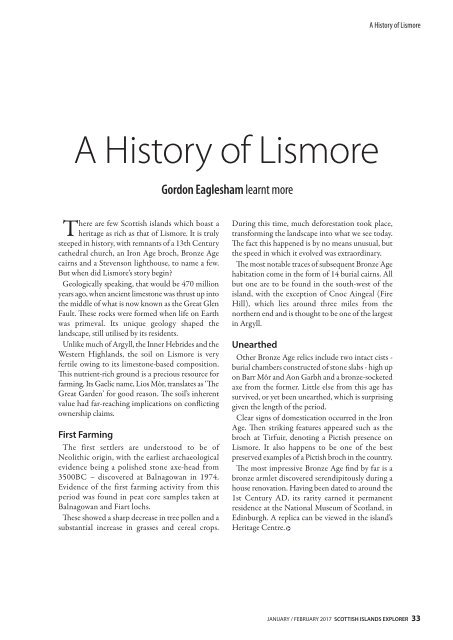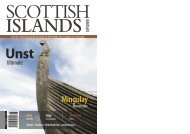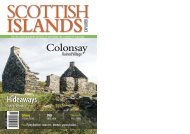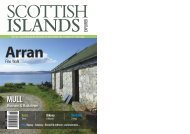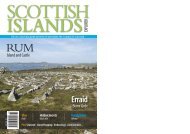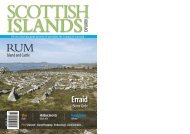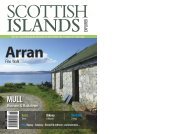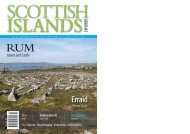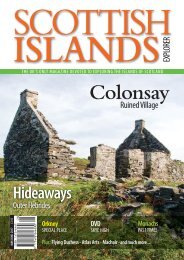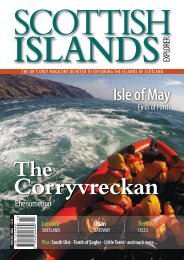You also want an ePaper? Increase the reach of your titles
YUMPU automatically turns print PDFs into web optimized ePapers that Google loves.
A History of Lismore<br />
A History of Lismore<br />
Gordon Eaglesham learnt more<br />
There are few <strong>Scottish</strong> islands which boast a<br />
heritage as rich as that of Lismore. It is truly<br />
steeped in history, with remnants of a 13th Century<br />
cathedral church, an Iron Age broch, Bronze Age<br />
cairns and a Stevenson lighthouse, to name a few.<br />
But when did Lismore’s story begin?<br />
Geologically speaking, that would be 470 million<br />
years ago, when ancient limestone was thrust up into<br />
the middle of what is now known as the Great Glen<br />
Fault. ese rocks were formed when life on Earth<br />
was primeval. Its unique geology shaped the<br />
landscape, still utilised by its residents.<br />
Unlike much of Argyll, the Inner Hebrides and the<br />
Western Highlands, the soil on Lismore is very<br />
fertile owing to its limestone-based composition.<br />
is nutrient-rich ground is a precious resource for<br />
farming. Its Gaelic name, Lios Mòr, translates as ‘e<br />
Great Garden’ for good reason. e soil’s inherent<br />
value had far-reaching implications on conflicting<br />
ownership claims.<br />
First Farming<br />
The first settlers are understood to be of<br />
Neolithic origin, with the earliest archaeological<br />
evidence being a polished stone axe-head from<br />
3500BC – discovered at Balnagowan in 1974.<br />
Evidence of the first farming activity from this<br />
period was found in peat core samples taken at<br />
Balnagowan and Fiart lochs.<br />
ese showed a sharp decrease in tree pollen and a<br />
substantial increase in grasses and cereal crops.<br />
During this time, much deforestation took place,<br />
transforming the landscape into what we see today.<br />
e fact this happened is by no means unusual, but<br />
the speed in which it evolved was extraordinary.<br />
e most notable traces of subsequent Bronze Age<br />
habitation come in the form of 14 burial cairns. All<br />
but one are to be found in the south-west of the<br />
island, with the exception of Cnoc Aingeal (Fire<br />
Hill), which lies around three miles from the<br />
northern end and is thought to be one of the largest<br />
in Argyll.<br />
Unearthed<br />
Other Bronze Age relics include two intact cists -<br />
burial chambers constructed of stone slabs - high up<br />
on Barr Môr and Aon Garbh and a bronze-socketed<br />
axe from the former. Little else from this age has<br />
survived, or yet been unearthed, which is surprising<br />
given the length of the period.<br />
Clear signs of domestication occurred in the Iron<br />
Age. en striking features appeared such as the<br />
broch at Tirfuir, denoting a Pictish presence on<br />
Lismore. It also happens to be one of the best<br />
preserved examples of a Pictish broch in the country.<br />
e most impressive Bronze Age find by far is a<br />
bronze armlet discovered serendipitously during a<br />
house renovation. Having been dated to around the<br />
1st Century AD, its rarity earned it permanent<br />
residence at the National Museum of Scotland, in<br />
Edinburgh. A replica can be viewed in the island’s<br />
Heritage Centre.<br />
JANUARY / FEBRUARY <strong>2017</strong> SCOTTISH ISLANDS EXPLORER 33


